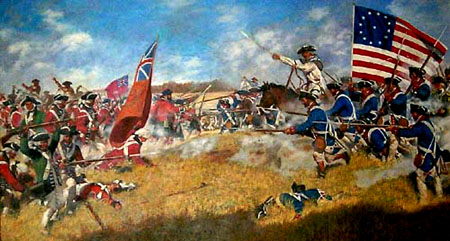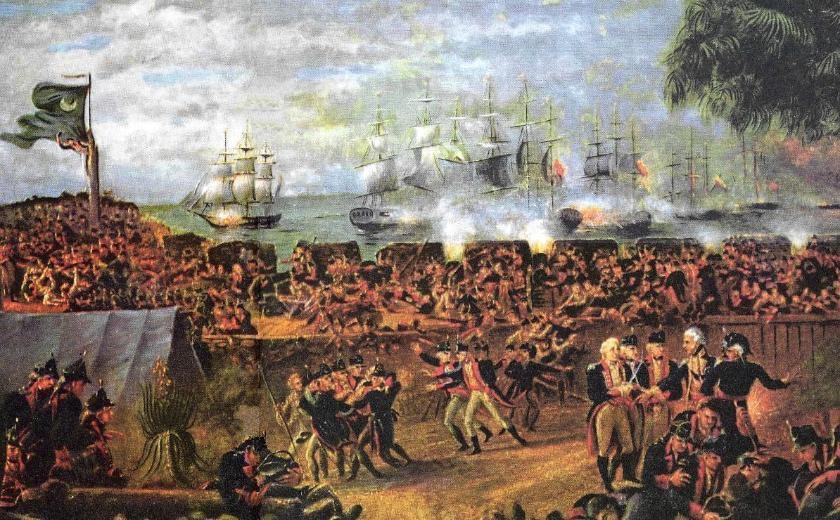
BATTLE OF KING'S MOUNTAIN
During the American Revolution, Patriot irregulars under Colonel William Campbell defeat Tories under Major Patrick Ferguson at the Battle of King’s Mountain in South Carolina. Major Ferguson’s Tory force, made up mostly of American Loyalists from South Carolina and elsewhere, was the western wing of General Lord Cornwallis’ North Carolina invasion force. One thousand American frontiersmen under Colonel Campbell of Virginia gathered in the backcountry to resist Ferguson’s advance. Pursued by the Patriots, Ferguson positioned his Tory force in defense of a rocky, treeless ridge named King’s Mountain. The Patriots charged the hillside multiple times, demonstrating lethal marksmanship against the surrounded Loyalists. Unwilling to surrender to a “band of banditti,” Ferguson led a suicidal charge down the mountain and was cut down in a hail of bullets. After his death, some of his men tried to surrender, but they were slaughtered in cold blood by the frontiersmen, who were bitter over British excesses in the Carolinas. The Tories suffered 157 killed, 163 wounded, and 698 captured. Colonel Campbell’s force suffered just 28 killed and 60 wounded.

Battle of Yorktown
General George Washington, commanding a force of 17,000 French and Continental troops, begins the siege known as the Battle of Yorktown against British General Lord Charles Cornwallis and a contingent of 9,000 British troops at Yorktown, Virginia, in the most important battle of the Revolutionary War. Earlier, in a stroke of luck for the Patriots, the French fleet commanded by Francois, Count de Grasse, departed St. Domingue (the then-French colony that is now Haiti) for the Chesapeake Bay, just as Cornwallis chose Yorktown, at the mouth of the Chesapeake, as his base. Washington realized that it was time to act. He ordered Marquis de Lafayette and an American army of 5,000 troops to block Cornwallis’ escape from Yorktown by land while the French naval fleet blocked the British escape by sea. By September 28, Washington had completely encircled Cornwallis and Yorktown with the combined forces of Continental and French troops. After three weeks of non-stop bombardment, both day and night, from cannon and artillery, Cornwallis surrendered to Washington in the field at Yorktown on October 17, 1781, effectively ending the War for Independence. Pleading illness, Cornwallis did not attend the formal surrender ceremony, held on October 19. Instead, his second in command, General Charles O’Hara, carried Cornwallis’ sword to the American and French commanders. Although the war persisted on the high seas and in other theaters, the Patriot victory at Yorktown ended fighting in the American colonies. Peace negotiations began in 1782, and on September 3, 1783, the Treaty of Paris was signed, formally recognizing the United States as a free and independent nation after eight years of war.

Americans suffer worst defeat of revolution at Charleston
After a siege that began on April 2, 1780, Americans suffer their worst defeat of the revolution on this day in 1780, with the unconditional surrender of Major General Benjamin Lincoln to British Lieutenant General Sir Henry Clinton and his army of 10,000 at Charleston, South Carolina. With the victory, the British captured more than 3,000 Patriots and a great quantity of munitions and equipment, losing only 250 killed and wounded in the process. Confident of British control in the South, Lieutenant General Clinton sailed north to New York after the victory, having learned of an impending French expedition to the British-occupied northern state. He left General Charles Cornwallis in command of 8,300 British forces in the South. South Carolina was a deeply divided state, and the British presence let loose the full violence of a civil war upon the population. First, the British used Loyalists to pacify the Patriot population; the Patriots returned the violence in kind. The guerrilla warfare strategies employed by Patriots Francis Marion, Thomas Sumter and Nathanael Greene throughout the Carolina campaign of 1780-81 eventually chased the far more numerous British force into Virginia, where they eventually surrendered at Yorktown on October 19, 1781. Having suffered the humiliation of surrendering to the British at Charleston, Major General Lincoln was able to turn the tables and accept Cornwallis’ ceremonial surrender to General George Washington at Yorktown on October 20.